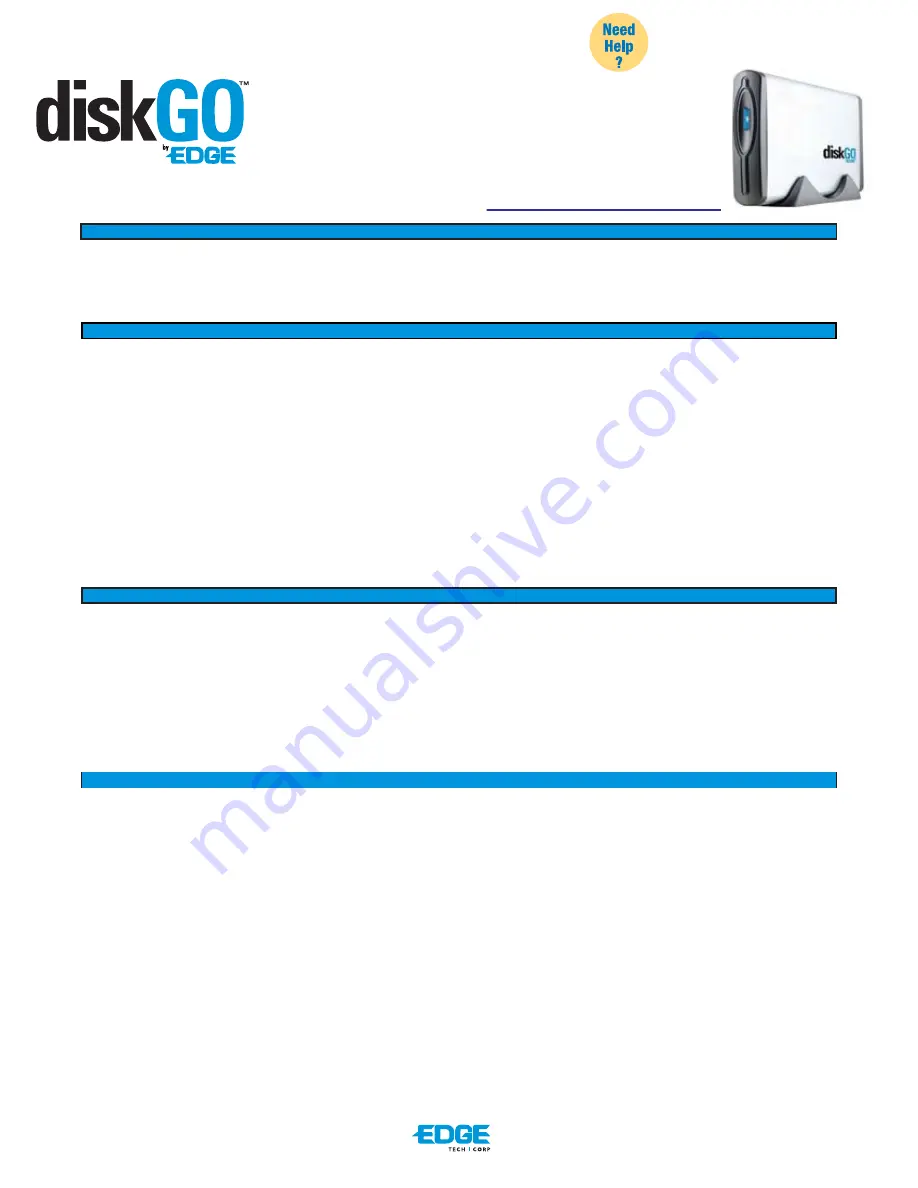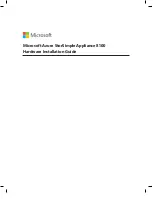
This Product is backed by a Three-Year Warranty.
For complete warranty information visit
www.edgetechcorp.com/register
CUSTOMER SUPPORT
www.edgetechcorp.com/support
Version 0409-3.0
DiskGO
TM
3.5" External
Hard Drive User Manual
www.edgetechcorp.com
EDGE and DiskGO are trademarks of EDGE Tech Corp. Trademarked words or logos used herein are property of their respective owners.
IMPORTANT INFORMATION
INSTALLATION AND USE
For more aditional information, please go to www.edgetechcorp.com/support.
DISCONNECTING YOUR DEVICE
INTRODUCTION
Thank you for purchasing the EDGE DiskGO™ 3.5" External Hard Drive! The following manual is designed to provide you with the
information necessary to set up and operate this product. Before beginning, please ensure that the following items were included:
● DiskGO™ 3.5" External Hard Drive
● USB cable
● Mounting stand
● Power adapter
®
®
™
®
Minimum System Requirements
Available
USB
port running one of the following operating systems: Windows
2000 or higher, Ma
c
OS
X or higher.
The DiskGO External Hard Drive is pre-formatted as FAT32. If you plan on sharing the flash drive between a
M
ac and a
P
C, you will need to
leave the drive formatted as FAT32 or change the format to FAT or FAT16. This will allow the drive to be used on either platform and
data shared between the two.
M
ac O
S ca
nnot read
the NTFS
file system.
If you intend to use your hard drive only in
Ma
c O
S
you must initialize the entire volume with
M
ac O
S
Extended (Warning: ALL DATA
WILL BE LO
S
T. Back up all data).
If you intend to use your device with both a
PC and
Ma
c, initialize each partition with
MS
-D
OS
(Warning: ALL DATA WILL BE LO
S
T).
MAC USERS: After connecting your DiskGO hard drive, it may take one minute or more for the drive icon to appear on
your desktop. DO NOT shut down or disconnect your hard drive during this time!
Additional Information
1. Connect the
USB
cable to the external hard drive.
2. Connect the supplied power cable to the external hard drive.
3. Connect the power adapter to an AC wall outlet.
4
. Press the power button on the front of the external hard drive. For capacities 1TB and higher, we recommend turning the fan to the ON
position (located on the back of the unit).
5.
P
lug the
USB
cable into the
USB
port of the computer.
6. Your DiskGO External Hard Drive will appear as an external drive in “
M
y Computer” and in “Windows Explorer.” The drive icon should
appear with the volume name
“DIS
KGO” (or similar) in
Ma
c O
S
and Windows. Windows should automatically assign a drive letter.
7. Once your drive appears in “
M
y Computer,” “Windows Explorer,” or on your
Ma
c O
S
desktop, you can then use it to read and write
files in the same way that you use your computer’s internal hard drive.
USB
external devices feature hot swappable “plug & play” connections. This means that your drive can be connected and disconnected
while the computer is running.
To prevent failures, it is important that you follow these steps when disconnecting any USB peripheral device.
Mac Users
You must unmount or ‘eject’ the drive unit before disconnecting it. To do this, drag the DiskGO icon to the trash.
PC Users (Windows XP and Vista)
Simply
disconnect the drive when it is not active (when the R/W activity lights are not blinking). No other steps are required.
PC Users (Windows 2000 and Windows ME)
You must unmount or ‘eject’ the drive unit before disconnecting it. To unmount the drive:
1. When you connect an external device, an “Eject” icon will appear in the Windows
S
ystem Tray. The Eject icon is a small green arrow
over a hardware image. The
S
ystem Tray is located near the clock in the lower right side of your screen. Double-click the “Eject” icon.
2. The
“Sa
fely Remove Hardware” dialog box will appear, listing the devices that the “Eject” icon controls (all external devices). Highlight
the device you wish to unmount and click the “
St
op” button.
3. The
“Stop
a Hardware Device” dialog box will appear, listing the device controllers assigned to that device. Highlight the top listing
and click “OK”.
4. You will then be given the following message,
“Sa
fe to Remove Hardware” (or similar). It is now safe to disconnect the device.
®



















